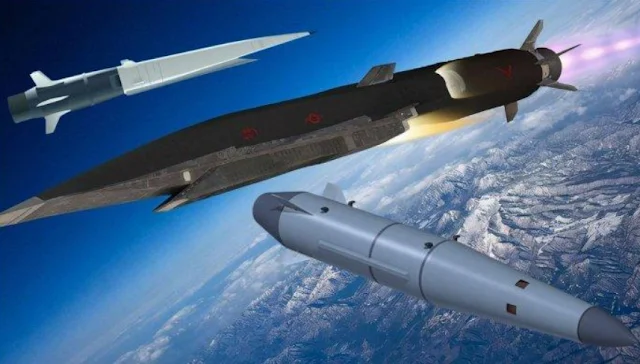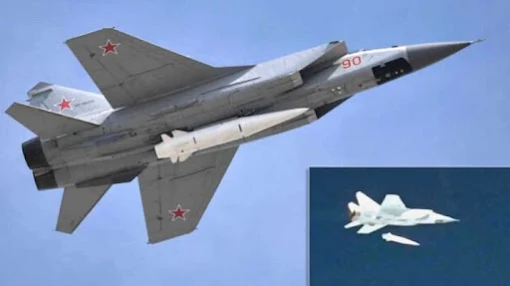 |
| Difference between Kinzhal and Zircon Hypersonic Missiles |
International Military - The Russian-Ukrainian war has indirectly raised the prestige of hypersonic weapons to the surface. Moreover, Russia has officially confirmed for the first time the use of hypersonic missiles on the Ukrainian battlefield. The Russian Ministry of Defense admits that it fired a Kinzhal hypersonic missile at an ammunition depot in the vicinity of the city of Deliatyn in southwestern Ukraine, on March 19, 2022. This is the first time the hypersonic weapon has been used in combat fired from a MiG 31 fighter.
Russia has been developing hypersonic missiles since 1980 and to date there are 3 Russian flagship hypersonic missiles that have entered military service. The three hypersonic missiles that Russia has successfully developed are the Kh-47M2 Kinzhal, 3M22 Zircon, and Avangard (Hypersonic Glide Vehicle).
The Kinzhal missile was first introduced by President Vladimir Putin on March 1, 2018, as one of Russia's six new strategic weapons. A week later, the Russian Aerospace Forces conducted the first test firing of a Kinzhal missile from a MiG-31B aircraft over Southwestern Russia.
Quoted from Missiledefenseadvocacy, the Kinzhal hypersonic missile has a range of more than 2,000 km, a speed of more than Mach 10, and evasive maneuverability at every stage of flight. The Kinzhal missile is capable of carrying a conventional warhead and can be replaced with a nuclear warhead weighing the same as 480 kg.
The Kinzhal missile is a modernization of the Iskander-M ballistic missile system, so the mention of it as a hypersonic missile is somewhat misleading. This is because almost all ballistic missiles reach hypersonic speeds or above Mach 5.
 |
| Kh-47M2 Kinzhal Hypersonic Missile and Iskander-M short range ballistic missile |
The Kinzhal missile, like the Iskander-M, has similar dimensions, namely 8 meters in length, 1 meter in body diameter, and a launch weight of around 4,300 kg. The difference is that the Iskander-M missile is launched from the ground, while the Kinzhal missile is launched from the air using a Tu-22M3 bomber or MiG-31K interceptor.
It can be interpreted that the Kinzhal missile is a ballistic missile that is launched from the air so that it can penetrate a maximum speed of Mach 10. Because it is launched from the air, the Kinzhal missile has a slightly different design, namely a smaller rudder and a missile tail to protect the engine nozzle during flight. Kinzhal missile targets are important military facilities on the ground, such as airports, weapons depots and command bases. Being launched from the air makes the Kinzhal missile difficult to detect and nearly impossible for counterair systems to intercept.
 |
| Tsirkon or Zircon hypersonic missiles |
Unlike the Tsirkon or Zircon hypersonic missiles. The missile, which has the code name Zircon 3M22 or SS-N-33, is an anti-ship hypersonic cruise missile. Zircon's estimated range is 500 km at low level and up to 750 km on semi-ballistic trajectories, but Russian media reports the range is as high as 1,000 km.
The Zircon missile works in two stages using solid fuel in the first stage and a scramjet motor in the second. The Zircon missile has strategic value due to its speed of Mach 8 during April 2017 testing. During flight, the Zircon missile is covered in a plasma cloud which absorbs radio frequency rays, making it invisible to radars. The Zircon missile can penetrate speeds of Mach 9 and fly at an altitude of 30-40 km due to less air resistance.
Quoted from The War Zone the Zircon missile has a length of 8-10 meters and carries a warhead weighing 300-400 kg. The Zircon missiles are fired from the 3S-14 universal vertical launcher commonly housed for warships, submarines, and the Bastion mobile coastal missile launcher.
Zircon missiles are designed to destroy enemy warships and aircraft carriers, which is why they are widely deployed on warships and submarines. The Russian Navy has deployed Zircon missiles on the Admiral Gorshkov and Admiral Grigorovich-class frigates, Gremyashchiy-class corvettes, and Yasen-class submarines.


